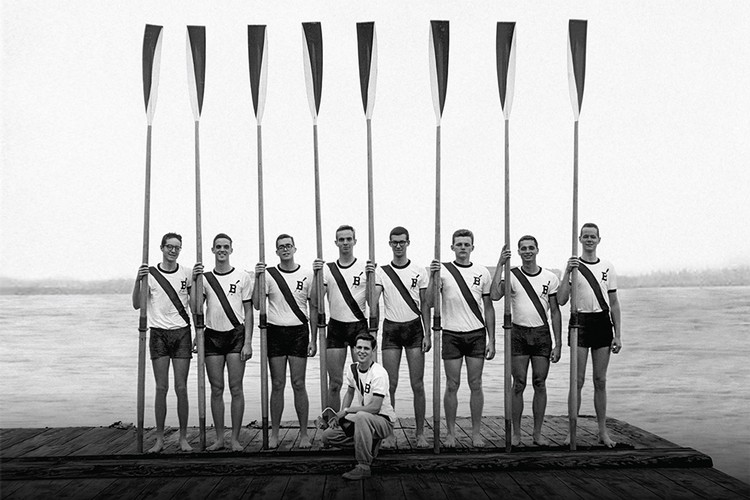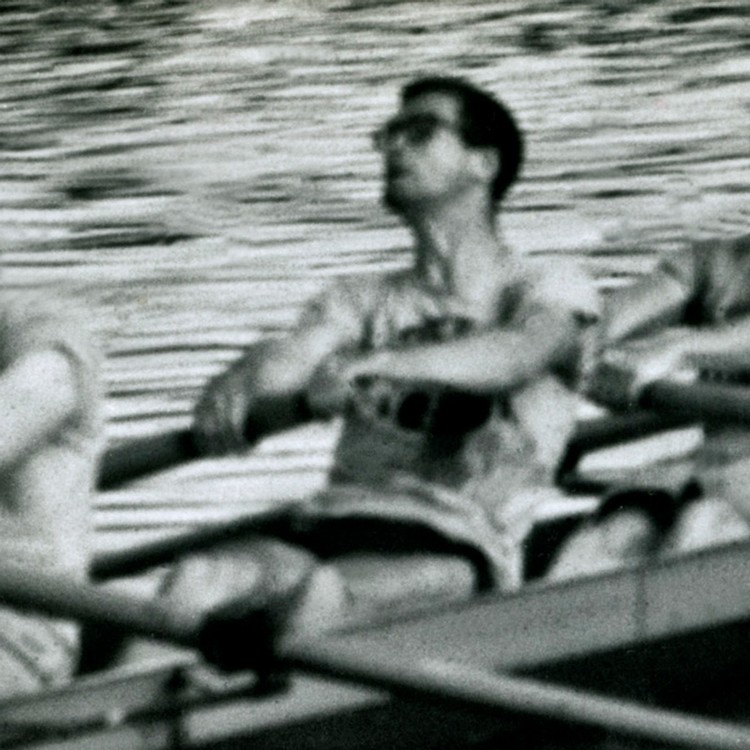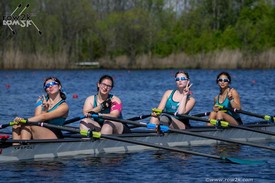
Any undefeated crew or team has evidence that it can beat anybody.
A fresh coach would therefore need X-ray vision to detect insecurities.
We had distinct body types in our crew. I can't remember any bandy legs characteristic of ancient nautical persons, but we had knock knees and straight knees for sure, along with the slightest of slight lack of confidence in one another.
Charlie Butt: "He's just as big and strong as anybody." I don't know whom he was talking about but am sure the person was stronger on days when his timing was good. Charlie also wanted everybody to know that Captain Barry Burns at 6 was one of the big men who made a major contribution to the boat.
If one considers an eight as four pairs, then Barry was paired with Doug Dysart, powerful but much shorter in the 1959 high stroking crew, and with Bob Olson, powerful and tall in the 1960 low stroking crew.
Charlie made us more aware of what we had.

I used to tell anyone who would listen that if a shoulder went out in one direction somebody else's elbow went out in the opposite direction thus keeping the boat balanced and level. Charlie might have admitted something along those lines to me twenty years later.
Such wild compensation was of course an insecure argument for seat security, but nobody had to hear it but my girlfriends.
The principle by which the winner of the Dad Vail next may compete in rowing's big league is a very good one but I don't think that most of the crews coming up have over the years discovered the same overlap in abilities that we did.
From coaching experience I don't believe that many Dad Vail crews are even aware of the other league, competing instead in their own pond. At West Virginia University a women's coxed four won a Dad Vail final and declared it a national championship and were correct.
We were an undefeated crew that had just won the final race of the largest collegiate regatta in North America. We had done so by jolting the catch and not running into anything and had prevailed over the next fastest crew in the regatta by "curvature of the earth."
So it wasn't as if we did wrong. It was just that Charlie, driven by the wish to do something significant for the one oarsman he ever underestimated, saw an area for slight improvement in seven out of the eight.
He didn't want to mess with the fact that we hit the catch together but had faith we could learn to do the same thing in a different way. At cue level, he taught us to move the blade with the legs.
On the theoretical level that does not happen. Just ask any crew coach and she or he will tell you that you anchor the oar and pry the boat past the blade.

I hadn't yet met Harry Parker but relate here what he told me in Cincinnati. You hit the catch hard with all three muscle groups. Do that and you get a great connection from the soles of your feet to your blade in the water. The legs naturally overpower the back which naturally overpowers the arms thus producing the smooth sequence everyone wants of legs back arms.
Harry, Charlie and his son Charley were on the same page. But that was not the only attention Charlie gave us in the short period of three three-mile time trials interspersed with recovery days (I found I could lose more than ten pounds per trial-- mostly in water regained by the next day.)
Before any of these trials Charlie did a systematic study of our "spacing," the distance between each discrete imprint of eight puddles or "fading footprints" as Homer called them and the best indicator of run in a rowing craft, i.e., the amount of glide between strokes.
And luckily for us he could tell from a single experienced look that we would go uncommonly fast at between 29 and 31 strokes per minute. The word got out at least in the rumor mill of Washington, DC that we were fast over three miles-- perhaps Charlie Butt revealed to someone what his stopwatch told him three separate times.
I emphasize this because of what happened after we did well in the IRA Championship-- surprise and pleasure and reams of useful publicity but silliness too.
If you enjoy and rely on row2k, we need your help to be able to keep doing all this. Though row2k sometimes looks like a big, outside-funded operation, it mainly runs on enthusiasm and grit. Help us keep it coming, thank you! Learn more.
Comments | Log in to comment |
There are no Comments yet
| |
- Bont Rowing
- Calm Waters Rowing
- Concept 2
- Craftsbury Sculling
- The Crew Classic
- CrewLAB
- Croker
- Dad Vail Regatta
- Durham Boat Co.
- Empacher
- Faster Masters
- Filippi
- Fluidesign
- h2row.net
- HUDSON
- Live2Row Studios
- Nielsen-Kellerman
- Oak Ridge RA
- Peinert Boat Works
- Pocock Racing Shells
- Race1 USA
- Rockland Rowing Masters Regatta
- RowKraft
- Rubini Jewelers
- Vespoli USA
- WinTech Racing
- Bont Rowing
- Calm Waters Rowing
- Concept 2
- Craftsbury Sculling
- The Crew Classic
- CrewLAB
- Croker
- Dad Vail Regatta
- Durham Boat Co.
- Empacher
- Faster Masters
- Filippi
- Fluidesign
- h2row.net
- HUDSON
- Live2Row Studios
- Nielsen-Kellerman
- Oak Ridge RA
- Peinert Boat Works
- Pocock Racing Shells
- Race1 USA
- Rockland Rowing Masters Regatta
- RowKraft
- Rubini Jewelers
- Vespoli USA
- WinTech Racing

















